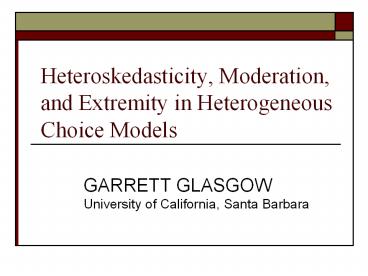Heteroskedasticity, Moderation, and Extremity in Heterogeneous Choice Models - PowerPoint PPT Presentation
Title:
Heteroskedasticity, Moderation, and Extremity in Heterogeneous Choice Models
Description:
Ordinal Dependent Variable. Heteroskedastic ordered probit model: ... Skewed Ordinal Dependent Variable With Heteroskedasticity. Race and Ambivalence, Model 2 ... – PowerPoint PPT presentation
Number of Views:168
Avg rating:3.0/5.0
Title: Heteroskedasticity, Moderation, and Extremity in Heterogeneous Choice Models
1
Heteroskedasticity, Moderation, and Extremity in
Heterogeneous Choice Models
- GARRETT GLASGOWUniversity of California, Santa
Barbara
2
Heterogeneous Choice Models
- Uncorrected heteroskedasticity in binary and
ordinal choice models will produce biased
estimates. - Heteroskedasticity may also be of substantive
interest. - Heterogeneous choice models developed to model
this heteroskedasticity.
3
Heteroskedasticity or Something Else?
- Unfortunately, in some cases heterogeneous choice
models will produce results that look like
heteroskedasticity when the error term is
actually homoskedastic. - I consider three cases here a binary dependent
variable, an ordinal dependent variable, and a
skewed ordinal dependent variable.
4
Case 1 Binary Dependent Variable
- Heteroskedasticity or Moderation?
5
Heterogeneous Choice, Binary Dependent Variable
- Heteroskedastic probit model
- As Hi increases, choice probabilities converge to
0.5.
6
Binary Dependent Variable With Heteroskedasticity
7
Binary Dependent Variable With Moderation
8
Monte Carlo Study
- Generated 1000 data sets, 1000 observations each.
y XB e. y 1 if ygt0, y 0 otherwise. - First condition half of observations have larger
error variance multiplied by 2 (heteroskedasticity
) - Second condition half of observations have
additional variable X/2 (moderation). - Estimated heteroskedastic probit under both
conditions.
9
Monte Carlo Results
- Heteroskedasticity and moderation can be
indistinguishable in the binary dependent
variable case.
10
Case 2 Ordinal Dependent Variable
- Heteroskedasticity or Extremity?
11
Heterogeneous Choice, Ordinal Dependent Variable
- Heteroskedastic ordered probit model
- As Hi increases, choice probabilities converge to
0.5 for extreme categories, 0 for middle
categories.
12
Ordinal Dependent Variable With Heteroskedasticity
13
Ordinal Dependent Variable With Extremity
14
Heterogeneous Choice, Ordinal Dependent
Variable, Model 2
- Modified heteroskedastic ordered probit model
- As Hi increases, choice probabilities converge to
1/M for each choice category. Variance in the
observed rather than latent variable.
15
Example 1 Working and Motherhood
16
Distribution of Warm by Gender
17
Example 2 Race and Ambivalence
18
Distribution of Quota by Ambivalence
19
Case 3 Skewed Ordinal Dependent Variable
- Heteroskedasticity or Left-Right?
20
Skewed Ordinal Dependent Variable With
Heteroskedasticity
21
Race and Ambivalence, Model 2
22
Conclusions
- Distinguishing heteroskedasticity from other
effects on the choice probabilities is difficult. - Several models considered, but all results could
be explained by effects other than
heteroskedasticity. - Perhaps this is a problem that must be solved
through theory and measurement rather than a
statistical model.

